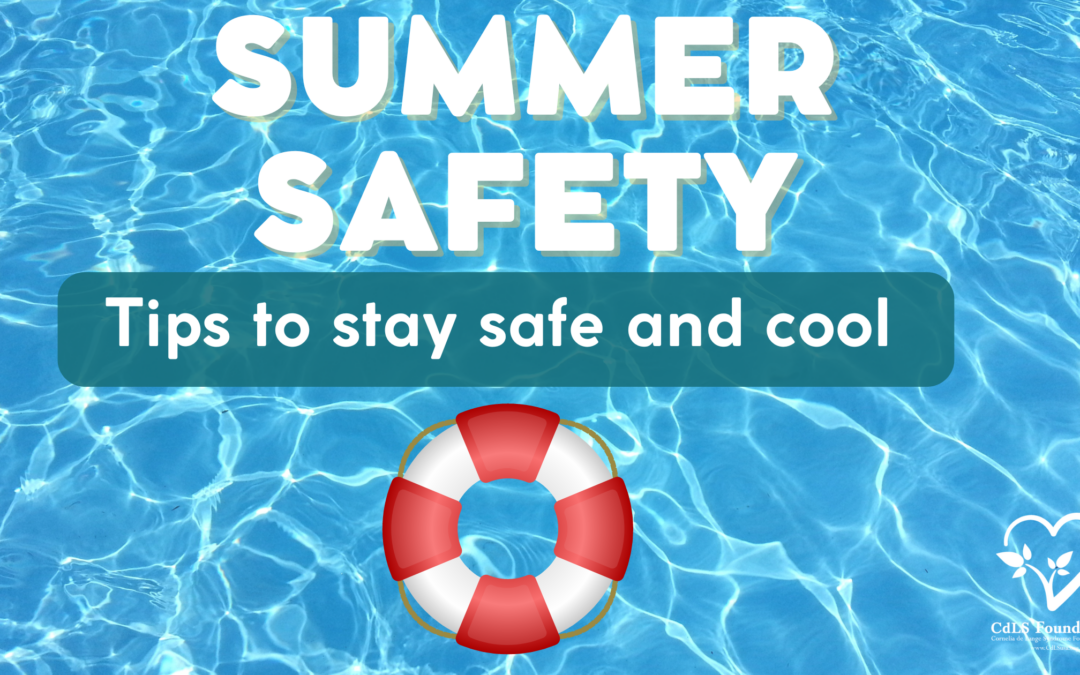Family Service Team
With its warmth and sunshine enticing us to be outside, summer temperatures and activities can pose some safety hazards. Here are some tips for keeping kids safe.
Keep Hydrated and Cool
Many children with special needs can be more susceptible to heat-related conditions. Certain medications can cause dryness in the mouth, increase sensitivity to the sun, or impair the body’s ability to perspire or regulate temperature. Be sure to ask your doctor or pharmacist if the medications you or your child take have warnings about sun exposure.
Avoid Sunburn
Most of us are familiar with sunburn’s pain and health risks. Be extra vigilant with children with disabilities, especially those who are non-verbal. Sunburn can also affect your body’s ability to cool itself and cause a loss of body fluids.
Seek shade during the hottest parts of the day to protect from UV rays. Remember that cloudy days do not block UV rays, so protection is still needed even when it’s cloudy. Cover up with clothing, a hat, and sunglasses, and apply sunscreen early and often. The CDC recommends using sunscreen with at least SPF 15 and labeled “broad-spectrum” to screen out UVB and UVA rays. Remember to protect ears, noses, lips, and the tops of feet.
Babies younger than six months should not be kept in direct sunlight because of their increased risk of heat stroke. The American Academy of Pediatrics advises that sunscreen can be used on small areas of the body, such as the face, when protective clothing and shade are not available.
Be Aware of Surfaces that Can Burn Sensitive Skin
Many children with CdLS have high pain thresholds and may not realize they are being burned. Metal frames of the wheelchair can cause burns, and when cushions heat up from sun exposure, the plastic covers may cause excessive sweating, leading to dehydration and skin breakdown. Protect your child from contact burns by covering any accessible armrests and metal frame portions of the chairs your child uses. Wheelchair umbrellas are one way to provide added protection.
Be Safe Around Water
Pools, lakes, or other watering holes are great places to swim and for family fun. It’s important to ensure everyone follows safety steps in and around the water. Whenever possible, swim near a lifeguard.
Parents and caregivers should still designate an official Water Watcher even when a lifeguard is present. A Water Watcher is an adult who is comfortable in the water, tasked with supervising those in the water. The designated Water Watcher shouldn’t read, text, or play games on their phone. The Water Watcher should have a phone with them in case they need to call for help.
Swimming is not only fun but also a lifesaving skill. Enroll children or adults in swimming lessons; many free or reduced-cost options are available from your local YMCA, USA Swimming chapter, or Parks and Recreation Department.
Proper fences, barriers, alarms, and covers can be lifesaving devices. A fence of at least four feet in height should surround the pool and not be climbable for children. The water should only be accessible through a self-closing, self-latching gate. install a door alarm from the house to the pool area.
Learning CPR can help save a life. Once you’re CPR certified, make sure to keep your certification current. CPR classes are available through many hospitals, community centers, through the American Red Cross at bit.ly/CPR_RedCross or the American Heart Association at bit.ly/AHA-CPR.

Recent Comments